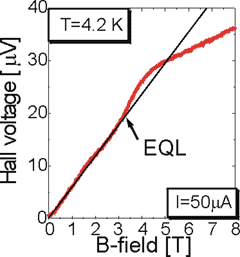| Introduction to STM | Instrumentation | Results / Projects |
| Gallery | Publications | Team |
Recent Results
Magnetic field induced localization in the extreme quantum limit
 |
| Fig. 2: dI/dV at V= 0 mV (LDOS at Fermi level). Different magnetic fields: B=2 T: Ballistic 3DES, B=3.3 T: partially localized 3DES, B=6 T: quantum Hall like state |
In the extreme quantum limit only the lowest spin polarized Landau level of a three dimensional electron system is occupied by electrons. This case is of particular importance for the understanding of interacting electron systems, since only in this case the different energies of the system scale different with magnetic field. While the kinetic energy decreases with increasing B-field, the electron-electron interaction stays nearly constant and the electron-dopant interaction increases with B-field. Low-gap semiconductors like InAs allow to reach this region in a quasi metalic state and STS allows to measure the density of states at the Fermi level. We can correlate the data with the peculiar knee-like structure in the Hall voltage, observed for the first time in 1954, but still not understood (Fig.1). The data suggest that the system proceeds from a ballistic electron system (Fig. 2) via a partially localized phase towards a phase where the overlapping localized states form one-dimensional conduction channels very similar to the quantum Hall state in two dimensional electron systems. The appearance of a gap like feature at the Fermi level in this last state (Fig. 3) points to the importance of electron-electron interactions in the extreme quantum limit.
 |
 |
| Fig. 1: Hall voltage of InAs(110), the transition to the extreme quantum limit (EQL) is marked, the straight line corresponds to the classically expected 3D-Hall resistivity (rhoxy) | Fig. 3: Spatially averaged dI/dV-spectrum at B = 6 T exhibiting a pseudogap at the Fermi level |
Related Publications
Introduction to STM | Instrumentation | Results / Projects | Gallery | Publications | Team
impressum © copyright 2002 by group R - university of hamburg

